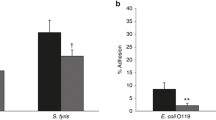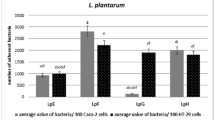Abstract
One of the main requirements for probiotics is their ability to survive during passage through gastrointestinal tract and to maintain their activity at different adverse conditions. The aim of the study was to look for the strains of lactobacilli and streptococci with high adhesive properties even affected by inhibitory substances, such as nitrates (NO3 −). To study the adhesion properties hemagglutination reaction of bacterial cells with red blood cells of different animals and humans was used. The acid formation ability of bacteria was determined by the method of titration after 7 days of incubation in the sterile milk. These properties were investigated at different concentrations of NO3 −. The high concentration (mostly ≥2.0 %) NO3 − inhibited the growth of both lactobacilli and streptococci, but compared with streptococcal cultures lactobacilli, especially Lactobacillus acidophilus Ep 317/402, have shown more stability and higher adhesive properties. In addition, the concentrations of NO3 − of 0.5–2.0 % decreased the acid-forming activity of the strains, but even under these conditions they coagulated milk and, in comparison to control, formed low acidity in milk. Thus, the L. acidophilus Ep 317/402 with high adhesive properties has demonstrated a higher activity of NO3 − transformation.

Similar content being viewed by others
Notes
INMIA Institute of Microbiology of Armenia.
References
Jakszyn P, Gonzalez CA (2006) Nitrosamine and related food intake and gastric and oesophageal cancer risk: a systematic review of the epidemiological evidence. World J Gastroenterol 12:4296–4303
Sindelar JJ, Milkowski AL (2012) Human safety controversies surrounding nitrate and nitrite in the diet. Nitric Oxide: Biol Chem 26:259–266
Gonzalez CA, Jakszyn P, Pera G et al (2006) Meat intake and risk of stomach and esophageal adenocarcinoma within the European prospective investigation into cancer and nutrition (EPIC). J Nat Cancer Inst 98:345–354
Hammes WP (2012) Metabolism of nitrate in fermented meats: the characteristic feature of a specific group of fermented foods. Food Microbiol 29:151–156
Larsson S, Orsini N, Wolk A (2006) Processed meat consumption and stomach cancer risk: a meta-analysis. J Natl Cancer Inst 98:1078–1087
Liu Ch, Russell RM (2008) Nutrition and gastric cancer risk: an update. Nutr Rev 66:237–249
Telford J, Barocchi M, Margarit I, Rappuoli R, Grandi G (2006) Pili in gram–positive pathogens. Nat Rev Microbiol 4(7):509–519
Bryan NS, Alexander DD, Coughlin JR, Milkowski AL, Boffeta P (2012) Ingested nitrate and nitrite and stomach cancer risk: An updated review. Food Chem Toxicol 50:3646–3665
Bourdichon F, Casaregola S, Farrokh C et al (2012) Food fermentations: microorganisms with technological beneficial use. Int J Food Microbiol 154:87–97
Reddy BS (1999) Possible mechanisms by which pro- and prebiotics influence colon carcinogenesis and tumor growth. J Nutr 129:1478–1482
World Health Organization [WHO] (2011) Nitrate and nitrite in drinking-water: background document for development of who guidelines for drinking-water quality, Geneva CH (accessed 2013 March 6), pp 10–13
Perdigón G, Fuller R, Raya R (2001) Lactic acid bacteria and their effects on the immune system. Curr Iss Intest Microbiol 2:27–42
Zhong L, Zhang X, Covasa M (2014) Emerging roles of lactic acid bacteria in protection against colorectal cancer. World J Gastroenterol 20:7878–7886
Braide W, Offor-Emenike I, Oranusi S (2014) Isolation and characterization of heterotrophic microorganisms and dominant lactic acid bacteria (LAB) from different brands of yoghurt and ice cream. Mer Res J Food Sci Technol 2:1–7
Pepoyan A, Trchounian A (2009) Biophysics, molecular and cellular biology of probiotic activity of bacteria. In: Trchounian A (ed) Bacterial membranes. Ultrastructure, bioelectrochemistry, bioenergetics and biophysics. Trivandrum, Signpost, pp 275–287
Jenkinson HF, Lamont RJ (1997) Streptococcal adhesion and colonization. Crit Rev Oral Biol Med 8:175–200
Iammarino M, Di Taranto A, Cristino M (2013) Endogenous levels of nitrites and nitrates in wide consumption foodstuffs: results of five years of official controls and monitoring. Food Chem 140:763–771
Mitacek EJ, Brunnemann KD, Suttajit M et al (2008) Geographic distribution of liver and stomach cancers in Thailand in relation to estimated dietary intake of nitrate, nitrite, and nitrosodimethylamine. Nutr Cancer 60:196–203
Avasilcăi L, Cuciureanu R (2011) Nitrates and nitrites in meat products—nitrosamines precursors. Rev Med Chir Soc Med Nat Iasi 115:606–611
Karlsson H, Hessle C, Rudin A (2002) Innate immune responses of human neonatal cells to bacteria from the normal gastrointestinal flora. Infect Immun 11:6688–6696
Jeanne A, Drisko MD, Cheryl K, Giles MD, Bette J, Bischoff RD (2003) Probiotics in health maintenance and disease prevention. Altern Med Rev 8:2
Holt JG (1994) Bergey’s manual of determinative bacteriology, 9th edn. Williams and Wilkins, Baltimore 787p
Soghomonyan D, Akopyan K, Trchounian A (2011) pH and oxidation-reduction potential change of environment during a growth of lactic acid bacteria: effects of oxidizers and reducers. Appl Biochem Microbiol 47:27–31
Harutyunyan K, Hakobyan L, Trchounian A (2014) Adhesive and antimicrobial properties of Lactobacillus acidophilus strain Er 317/402 “Narine” for its use in some types of blood cancer. FEBS J 282:728–729
Harutyunyan NM, Lalayan AA, Aleksanyan YuT, Melik-Andreasyan GG, Harutyunyan KV, Trchounian AA (2015) Comparative estimation of adhesiveness of conditional pathogenic enterobacteria and probiotic lactic acid bacteria. Med Sci Armenia 55(2):48–52
Ofek I, Doyle R (1994) Bacterial adhesion to cells and tissues. Chapman & Hall, New York, pp 513–562
Pearson D. (1972) Laboratory techniques In Food analysis. Dairy products. London & Boston: Butterworths, pp 131–166
Hairullin DD, Zhestkov NN (2011) Hematologic and electrocardiographic sheep indices at nitrates and nitrites poisoning. Proc Kazan State Acad Vet Med 208:288–293
Dimitrov Z, Gotova I, Chorbadjiyska E (2014) In vitro characterization of the adhesive factors of selected probiotics to Caco-2 epithelium cell line. Biotechnol Biotech Equipment 28:1079–1083
Hsieh P-S, An Y, Tsai Y-C, Chen Y-C, Chuang C-J, Zeng G-T, Wang G-T, King A-E (2013) Potential of probiotic strains to modulate the inflammatory responses of epithelial and immune cells in vitro. New Microbiol 36:167–179
Ranadheera SC, Evans GA, Adams MC, Baines CK (2014) Effect of dairy probiotic combinations on in vitro gastrointestinal tolerance, intestinal epithelial cell adhesion and cytokine secretion. J Funct Foods 8:18–25
Sunkata R, Herring J, Walker T, Verghese M (2014) Chemo-preventive potential of probiotics and prebiotics. Food Nutr Sci 5:1800–1809
An YH, Dickinson RB, Doyle RJ (2000) Mechanisms of bacterial adhesion and pathogenesis of implant and tissue infections. In: An YH, Friedman RG (eds) Handbook of bacterial adhesion: principles, methods, and applications. Springer, Berlin, pp 1–27
Macfarlane S, Macfarlane GT (2003) Regulation of short-chain fatty acid production. Proc Nutr Soc 62:67–72
Ricke SC (2003) Perspectives on the use of organic acids and short chain fatty acids as antimicrobials. Poultr Sci 82:632–639
Ou J, Carbonero F, Zoetendal EG, DeLany JP, Wang M, Newton K et al (2013) Diet, microbiota, and microbial metabolites in colon cancer risk in rural africans and african americans. Am J Clin Nutr 98:111–120
Alemayehu D, O’Sullivan E, Condon S (2000) Change in acid tolerance of Lactococcus lactis during growth at constant pH. Int J Food Microbiol 55:215–221
Acknowledgments
The study was supported by Basic Support for Research from State Committee of Science, Ministry of Education and Science of Armenia (#10-3/9).
Author information
Authors and Affiliations
Corresponding author
Ethics declarations
Conflict of interest
There is no conflict of interest.
Rights and permissions
About this article
Cite this article
Hakobyan, L., Harutyunyan, K., Harutyunyan, N. et al. Adhesive Properties and Acid-Forming Activity of Lactobacilli and Streptococci Under Inhibitory Substances, Such as Nitrates. Curr Microbiol 72, 776–782 (2016). https://doi.org/10.1007/s00284-016-1017-9
Received:
Accepted:
Published:
Issue Date:
DOI: https://doi.org/10.1007/s00284-016-1017-9




